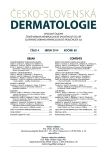-
Medical journals
- Career
Arthroderma benhamiae as a Causative Agent of Tinea Capitis Profunda nad Tinea Corporis in Children
Authors: N. Mallátová 1; H. Janatová 2; K. Kocourková 1; V. Hubka 4,5; S. Dobiášová 6; P. Širůček 7; J. Nováková 8; K. Šimečková 9
Authors‘ workplace: Pracoviště parazitologie a mykologie, Centrální laboratoře Nemocnice České Budějovice a. s. ředitel nemocnice MUDr. Břetislav Shon 1; Kožní oddělení, Nemocnice České Budějovice a. s. ředitel nemocnice MUDr. Břetislav Shon 2; Dětské oddělení, Nemocnice České Budějovice a. s. ředitel nemocnice MUDr. Břetislav Shon 3; Katedra botaniky, Přírodovědecká fakulta, Univerzita Karlova v Praze vedoucí katedry doc. RNDr. Yvonne Němcová, Ph. D. 4; Laboratoř genetiky a metabolismu hub, Mikrobiologický ústav, Akademie věd České republiky, v. v. i., Praha vedoucí Mgr. Miroslav Kolařík, Ph. D. 5; Oddělení bakteriologie a mykologie, Centrum klinických laboratoří, Zdravotní ústav se sídlem v Ostravě vedoucí oddělení RNDr. Vladislav Holec 6; Klinika infekčního lékařství, Fakultní nemocnice Ostrava přednosta kliniky doc. MUDr. Luděk Rožnovský, CSc. 7; Kožní oddělení, Fakultní nemocnice Ostrava primářka MUDr. Yvetta Vantuchová, Ph. D. 8; Dermatovenerologická ambulance, s. r. o., Hlučín 9
Published in: Čes-slov Derm, 89, 2014, No. 4, p. 199-204
Category: Case Reports
Overview
Tinea capitis and tinea corporis are dermatophytoses mostly appearing in childhood. Depending on the type of causative dermatophyte they might present as a superficial mycosis or a deep infection with a serious inflammatory reaction. Microsporum canis is the most common pathogen in our climate. Tinea capitis is treated by systemic antifungals, mostly terbinafine and intraconazole, tinea corporis requires local or systemic treatment according to the disease extent. We present three children with tinea capitis and corporis caused by an atypical dermatophyte Arthroderma benhamiae, spreading from an infected guinea pig. The first case manifested as a strong inflammatory lesion on the scalp of a ten-year old girl with systemic symptoms. Systemic terbinafine therapy failed. The second case describes infection in two siblings successfully treated by combination of systemic terbinafine and local therapy. The former systemic therapy of tinea capitis by fluconazole and local ciclopirox olamine treatment was not successful in one of the siblings.
Key words:
tinea capitis – tinea corporis – zoofilic dermatophytes – Arthroderma benhamiae – guinea pig – fluconazole – terbinafine – posaconazole
Sources
1. BARANOVÁ, Z. Dva prípady tinea capitis (kerion Celsi) u detí liečených pulznou liečbou itrakonazolom. Čes.-slov. Pediat., 2000, 55, p. 568–573.
2. BARCHIESI, F., ARZENI, D., CAMILETTI, V. et al. In vitro activity of posaconazole against clinical isolates of dermatophytes. J. Clin. Microbiol., 2001, 39, p. 4208–4209.
3. BRAUN, S., JAHN, K., WESTERMANN, A., BRUCH-GERHARZ, D., REIFENBERGER, P. D. J. Tinea barbae profunda durch Arthroderma benhamiae. Hautarzt, 2013, 64, p. 720–722.
4. FUMEAUX, J., MOCK, M., NINET, B. et al. First report of Arthroderma benhamiae in Switzerland. Dermatology, 2004, 208, p. 244–250.
5. GINTER–HANSELMAYER, G., WEGER, W., ILKIT, M., SMOLLE, J. Epidemiology of tinea capitis in Europe: current state and changing patterns. Mycoses, 2007, 50, p. 6–13.
6. GUPTA, A. K., NOLTING, S., DE PROST, Y. et al. The use of itraconazole to treat cutaneous fungal infections in children. Dermatology, 1999, 199, p. 248–252.
7. GUPTA, A. K., ADAM, P., DLOVA, N. et al. Therapeutic options for the treatment of tinea capitis caused by Trichophyton species: griseofulvin versus the new oral antifungal agents, terbinafine, itraconazole, and fluconazole. Pediatr. Dermatol., 2001, 18, p. 433–438.
8. HABER, J., MALLÁTOVÁ, N. Posakonazol. Remedia, 2007, 17, p. 50–60.
9. HUBKA, V., KUBATOVA, A., MALLATOVA, N. et al. Rare and new aetiological agents revealed among 178 clinical Aspergillus strains obtained from Czech patients and characterised by molecular sequencing. Med. Mycol., 2012, 50, p. 601–610.
10. KAKOUROU, T., UKSAL, U. Guidelines for the management of tinea capitis in children. Pediatr. Dermatol., 2010, 27, p. 226–228.
11. KUKLOVA, I., KUČEROVÁ, H. Dermatophytoses in Prague, Czech Republic, between 1987 and 1998. Mycoses, 2001, 44, p. 493–496.
12. MALLÁTOVÁ, N., UTTLOVÁ, K., SMRČKA, V., MENCL, K. Trichophyton verrucosum jako neobvyklý původce infekce rány ve vlasaté části hlavy. Čes.-slov. Pediat., 2009, 64, p. 476–479.
13. MICHAELS, B. D., DEL ROSSO, J. Q. Tinea capitis in infants: recognition, evaluation, and management suggestions. J. Clin. Aesthet. Dermatol., 2012, 5, p. 49–59.
14. MOCK, M., MONOD, M., BAUDRAZ–ROSSELET, F., PANIZZON, R. G. Tinea capitis dermatophytes: susceptibility to antifungal drugs tested in vitro and in vivo. Dermatology, 1998, 197, p. 361–367.
15. NENOFF, P., SCHULZE, I., UHRLAß, S., KRÜGER, C. Kerion Celsi durch den zoophilen Dermatophyten Trichophyton species von Arthroderma benhamiae bei einem Kind. Hautarzt, 2013, 64, p. 846–850.
16. REBOLLO, N., LÓPEZ-BARCENAS, A., ARENAS, R. Tinea capitis. Actas Dermosifiliogr., 2008, 99, p. 91–100.
17. SKOŘEPOVÁ, M. Tinea capitis – staronový problém. Klin. Mikrobiol. Inf. Lék., 2007, 13, p. 156–159.
Labels
Dermatology & STDs Paediatric dermatology & STDs
Article was published inCzech-Slovak Dermatology

2014 Issue 4-
All articles in this issue
- Recent Advances in Taxonomy of Dermatophytes and Recommendations for Using Names of Clinically Important Species
- Molecular Epidemiology of Dermatophytoses in the Czech Republic – Two-Year-Study Results
- Detection, Identification and Typization of Dermatophytes by Molecular Genetic Methods
- A Case of Tinea Corporis caused by Microsporum Incurvatum – a Geophillic Species related to M. gypseum
- Our first Experiences with Infections Caused by Arthroderma benhamiae (Trichophyton sp.)
- Arthroderma benhamiae as a Causative Agent of Tinea Capitis Profunda nad Tinea Corporis in Children
- Czech-Slovak Dermatology
- Journal archive
- Current issue
- Online only
- About the journal
Most read in this issue- Our first Experiences with Infections Caused by Arthroderma benhamiae (Trichophyton sp.)
- A Case of Tinea Corporis caused by Microsporum Incurvatum – a Geophillic Species related to M. gypseum
- Arthroderma benhamiae as a Causative Agent of Tinea Capitis Profunda nad Tinea Corporis in Children
- Recent Advances in Taxonomy of Dermatophytes and Recommendations for Using Names of Clinically Important Species
Login#ADS_BOTTOM_SCRIPTS#Forgotten passwordEnter the email address that you registered with. We will send you instructions on how to set a new password.
- Career

